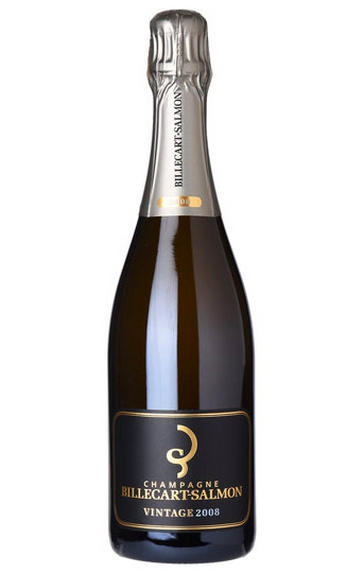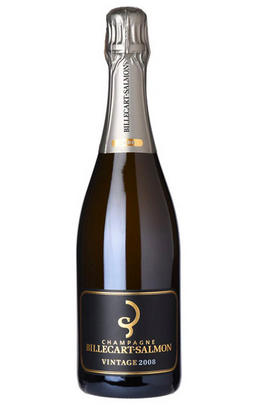
2008 Champagne Billecart-Salmon, Brut

Critics reviews
Disgorged with four grams per liter dosage, the 2008 Extra Brut Vintage hasn't appreciably evolved since I last tasted it. Offering up pretty aromas of honeycomb, crisp green apple, white flowers and fresh pastry, it's medium to full-bodied, tensile and incisive, with a tightly wound core, racy acids and an elegant pinpoint mousse. I wouldn't open bottles from my own cellar for another five years, as this is evolving at a glacial pace.
William Kelley, The Wine Advocate (February 2021)
Not as broad as the 2006. Very good for shellfish, and sauced dishes. Dense, serious, concentrated nose. Very tight. Only just approachable. Very satisfying. Great concentration. Piercing. Long. Still chewy. Very directed. Notably dry but not painful. Approach from the end of 2019… Opens out on the end.
Jancis Robinson MW, JancisRobinson.com (February 2021)
A stunningly pure nose with aromas of apples, pears, grapefruit, dried flowers and fresh bread dough, all intermingled. The palate has a super fresh, sleek and vibrant feel with elegance, length and precision. The finish is so long and so precise. A stunning Champagne.
Drink or hold
James Suckling, JamesSuckling.com (February 2021)
About this WINE

Champagne Billecart-Salmon
Champagne Billecart-Salmon was founded in 1818 in the village of Mareuil-sur-Aÿ near Epernay. It remains family-owned and run; Mathieu Roland-Billecart represents the seventh generation here, following in the footsteps of founders Nicolas-François Billecart and Elisabeth Salmon.
A family tasting committee meets weekly, joined by chef du cave Florent Nys. The eight-person panel includes three generations of the family, notably including Jean Roland-Billecart (who alone has over 75 vintages of experience). Not one cuvée is released until every member of the committee agrees on the blend.
Billecart-Salmon is a large Champagne House, with around 100 hectares of vines of its own. The process of organic conversion for the vineyards was started in 2019. The house also buys fruit from growers covering another 300 hectares of vines. Most of the fruit comes from the Champagne sub-regions of Montagne de Reims, Vallée de la Marne and Côte des Blancs.

Brut Champagne
Brut denotes a dry style of Champagne (less than 15 grams per litre). Most Champagne is non-vintage, produced from a blend from different years. The non-vintage blend is always based predominately on wines made from the current harvest, enriched with aged wines (their proportion and age varies by brand) from earlier harvests, which impart an additional level of complexity to the end wine. Champagnes from a single vintage are labelled with the year reference and with the description Millésimé.
Non-vintage Champagnes can improve with short-term ageing (typically two to three years), while vintages can develop over much longer periods (five to 30 years). The most exquisite and often top-priced expression of a house’s style is referred to as Prestige Cuvée. Famous examples include Louis Roederer's Cristal, Moët & Chandon's Dom Pérignon, and Pol Roger's Cuvée Sir Winston Churchill.
Recommended Producers : Krug, Billecart Salmon, Pol Roger, Bollinger, Salon, Gosset, Pierre Péters, Ruinart

Champagne blend
Which grapes are included in the blend, and their proportion, is one of the key factors determining the style of most Champagnes. Three grapes are used - Pinot Noir, Chardonnay and Pinot Meunier.
26% of vineyards in Champagne are planted with Chardonnay and it performs best on the Côtes des Blancs and on the chalk slopes south of Epernay. It is relatively simple to grow, although it buds early and thus is susceptible to spring frosts. It produces lighter, fresher wines than those from Burgundy and gives finesse, fruit and elegance to the final blend. It is the sole grape in Blancs de Blancs, which are some of the richest long-lived Champagnes produced.
Pinot Noir accounts for nearly 40% of the plantings in Champagne and lies at the heart of most blends - it gives Champagne its body, structure, strength and grip. It is planted across Champagne and particularly so in the southern Aube district.
The final component is Pinot Meunier and this constitutes nearly 35% of the plantings. Its durability and resistance to spring frosts make the Marne Valley, a notorious frost pocket, its natural home. It ripens well in poor years and produces a soft, fruity style of wine that is ideal for blending with the more assertive flavours of Pinot Noir. Producers allege that Pinot Meunier lacks ageing potential, but this does not deter Krug from including around 15% of it in their final blends.


Buying options
Add to wishlist
Description
Precision, pleasure & elegance is what I always associate with Billecart Salmon. And in a vintage as fabled as 2008, these hallmark traits are revealed in greater detail. The Billecart Vintage 2008 is pure joy, tiny, steady bubbles stream through wild gold in the glass.
The nose is filled with baked russet apples, waxy lemons and the golden crumb of cherry crumble, all supported by the noble Pinot vinosity of Grand Cru terroir. The palate is a roasted medley of peach, Red Macintosh and white cherry, very seductive, very classy.
Pinot noir leads the mid palate, earthy and richly textured, with the hallmark tension of the vintage extending the palate with an electric Cotes des Blancs, mouth-watering tang. The mousse is silky and seamless, the finish is tart tartin with saffron flecked Chantilly cream.
The wine has benefitted from time in bottle, drinking beautifully now.
Davy Zyw, Senior Buyer, Berry Bros. & Rudd (February 2021)
wine at a glance
Delivery and quality guarantee